List of Pinus species
Pinus, the pines, is a genus of approximately 111 extant tree and shrub species. The genus is currently split into two subgenera: subgenus Pinus (hard pines), and subgenus Strobus (soft pines). Each of the subgenera have been further divided into sections based on chloroplast DNA sequencing[1] and whole plastid genomic analysis.[2] Older classifications split the genus into three subgenera – subgenus Pinus, subgenus Strobus, and subgenus Ducampopinus (pinyon, bristlecone and lacebark pines)[3] – based on cone, seed and leaf characteristics. DNA phylogeny has shown that species formerly in subgenus Ducampopinus are members of subgenus Strobus, so Ducampopinus is no longer used.[1]
| Pinus |
| ||||||||||||||||||||||||||||||||||||||||||||||||||||||||||||
The species of subgenus Ducampopinus were regarded as intermediate between the other two subgenera. In the modern classification, they are placed into subgenus Strobus, yet they did not fit entirely well in either so they were classified in a third subgenus. In 1888 the Californian botanist John Gill Lemmon placed them in subgenus Pinus. In general, this classification emphasized cone, cone scale, seed, and leaf fascicle and sheath morphology, and species in each subsection were usually recognizable by their general appearance. Pines with one fibrovascular bundle per leaf, (the former subgenera Strobus and Ducampopinus) were known as haploxylon pines, while pines with two fibrovascular bundles per leaf, (subgenus Pinus) were called diploxylon pines. Diploxylon pines tend to have harder timber and a larger amount of resin than the haploxylon pines. The current division into two subgenera (Pinus and Strobus) is supported with rigorous genetic evidence.
Several features are used to distinguish the subgenera, sections, and subsections of pines: the number of leaves (needles) per fascicle, whether the fascicle sheaths are deciduous or persistent, the number of fibrovascular bundles per needle (2 in Pinus or 1 in Strobus), the position of the resin ducts in the needles (internal or external), the presence or shape of the seed wings (absent, rudimentary, articulate, and adnate), and the position of the umbo (dorsal or terminal) and presence of a prickle on the scales of the seed cones.[4]
Subgenus Pinus
Subgenus Pinus includes the yellow and hard pines. Pines in this subgenus have one to five needles per fascicle and two fibrovascular bundles per needle, and the fascicle sheaths are persistent, except in P. leiophylla and P. lumholtzii. Cone scales are thicker and more rigid than those of subgenus Strobus, and cones either open soon after they mature or are serotinous.[5]
Section Pinus
Section Pinus has two or three needles per fascicle. Cones of all species have thick scales, and all except those of P. pinea open at maturity. Species in this section are native to Europe, Asia, and the Mediterranean, except for P. resinosa in northeastern North America and P. tropicalis in western Cuba.[5]
Subsection Incertae sedis
- †P. driftwoodensis – Early Eocene, British Columbia, Canada[6]
Subsection Pinus
All but two species in Subsection Pinus are native to Eurasia.[5]
| Image | Leaves & Cone | Scientific name | Common Name | Distribution |
|---|---|---|---|---|
 | _-_Flickr_-_S._Rae.jpg.webp) | P. densata | Sikang pine | China. |
 |  | P. densiflora | Korean red pine | Japan, the Korean Peninsula, northeastern China (Heilongjiang, Jilin, Liaoning, Shandong) and the extreme southeast of Russia (southern Primorsky Krai). |
 |  | P. fragilissima | southeastern Taiwan. | |
| P. henryi | Henry's pine | China. | ||
.jpg.webp) |  | P. hwangshanensis | Huangshan pine | eastern China, in the provinces of Anhui, Fujian, Guizhou, Hubei, Hunan, Jiangxi, and Zhejiang |
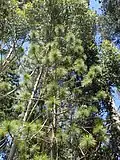 |  | P. kesiya | Khasi pine | the Khasi Hills in the northeast Indian state of Meghalaya, to northern Thailand, Philippines, Burma, Cambodia, Laos, southernmost China, and Vietnam. |
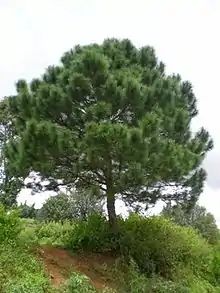 |  | P. latteri | Tenasserim pine | southeastern Burma, northern Thailand, Laos, Cambodia, Vietnam, and on the Chinese island of Hainan. |
.jpg.webp) | 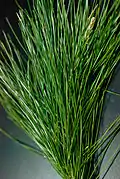 | P. luchuensis | Luchu pine | Ryukyu Islands of Japan |
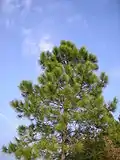 |  | P. massoniana | Masson's pine | Taiwan, and a wide area of central and southern China, including Hong Kong, and northern Vietnam, |
 | P. merkusii | Sumatran pine | northern Sumatra, and with two outlying populations in central Sumatra on Mount Kerinci and Mount Talang, and in the Philippines on Mindoro and in the Zambales Mountains on western Luzon. | |
 |  | P. mugo | mountain pine | southwestern to Central Europe and Southeast Europe. |
 |  | P. nigra | European black pine | Iberian Pensinsula to the eastern Mediterranean, on the Anatolian peninsula of Turkey on Corsica and Cyprus as well as Crimea and in the high mountains of Northwest Africa. |
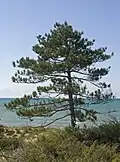 |  | P. resinosa | red pine | Newfoundland west to Manitoba, and south to Pennsylvania, with several smaller, disjunct populations occurring in the Appalachian Mountains in Virginia and West Virginia, as well as a few small pockets in extreme northern New Jersey and northern Illinois. |
 |  | P. sylvestris | Scots pine | Eurasia, ranging from Western Europe to Eastern Siberia, south to the Caucasus Mountains and Anatolia, and north to well inside the Arctic Circle in Fennoscandia |
 | _-_cone_(30927129400).jpg.webp) | P. tabuliformis | Chinese red pine | northern China from Liaoning west to Inner Mongolia and Gansu, and south to Shandong, Henan and Shaanxi, and also northern Korea. |
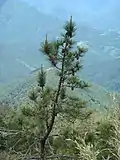 |  | P. taiwanensis | Taiwan red pine | Taiwan. |
 |  | P. thunbergii | Japanese black pine | Japan (Kyūshū, Shikoku and Honshū) and South Korea. |
 | 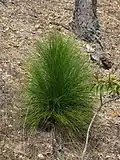 | P. tropicalis | tropical pine | Cuba. |
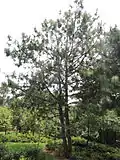 |  | P. yunnanensis | Yunnan pine | Yunnan, Sichuan, Guizhou, and Guangxi |
Subsection Pinaster
Subsection Pinaster contains species native to the Mediterranean, as well as P. roxburghii from the Himalayas. The scales of its cones lack spines.[4] It is named after P. pinaster.
| Image | Leaves & Cone | Scientific name | Common Name | Distribution |
|---|---|---|---|---|
 | .jpg.webp) | P. brutia | Turkish pine | Turkey, but it also extends to southeastern most Bulgaria, the East Aegean Islands of Aegean Sea, Crete, the Crimea, Iran, Georgia, Azerbaijan, northern Iraq, western Syria, Israel, north-west Jordan, Lebanon, and Cyprus. |
 |  | P. canariensis | Canary Island pine | outer Canary Islands (Gran Canaria, Tenerife, El Hierro and La Palma) |
.jpg.webp) | .jpg.webp) | P. halepensis | Aleppo pine | Morocco, Algeria, Tunisia and Spain north to southern France, Malta, Italy, Croatia, Montenegro, and Albania, and east to Greece. |
 |  | P. heldreichii | Bosnian pine | Balkans and southern Italy. |
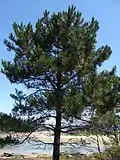 | .jpg.webp) | P. pinaster | maritime pine | Portugal and Northern Spain (especially in Galicia) to southern and Western France, east to western Italy, Croatia and south to northern Tunisia, Algeria and northern Morocco. |
.JPG.webp) |  | P. pinea | stone pine | Southern Europe, The Palestinian Territories, Lebanon and Syria. |
 |  | P. roxburghii | chir pine | Tibet and Afghanistan through Pakistan, across northern India in Jammu and Kashmir, Himachal Pradesh, Uttarakhand, Sikkim, Arunachal Pradesh), Nepal and Bhutan, to Myanmar. |
Section Trifoliae
Section Trifoliae (American hard pines), despite its name (which means "three-leaved"), has two to five needles per fascicle, or rarely eight. The cones of most species open at maturity, but a few are serotinous. All but two American hard pines belong to this section.[5]
Subsection Australes
Subsection Australes is native to North and Central America and islands in the Caribbean.[4][7][8] The closed-cone (serotinous) species of California and Baja California, P. attenuata, P. muricata, and P. radiata, are sometimes placed in a separate subsection, Attenuatae.[9]
| Image | Leaves & Cone | Scientific name | Common Name | Distribution |
|---|---|---|---|---|
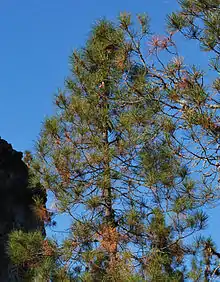 |  | P. attenuata | knobcone pine | southern Oregon to Baja California with the greatest concentration in northern California and the Oregon-California border. |
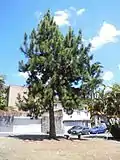 |  | P. caribaea | Caribbean pine | Central America, Cuba, the Bahamas, and the Turks and Caicos Islands. |
 | P. cubensis | Cuban pine | eastern highlands of the island of Cuba | |
 |  | P. echinata | shortleaf pine | eastern United States from southernmost New York, south to northern Florida, west to eastern Oklahoma, and southwest to eastern Texas |
.jpg.webp) | .jpg.webp) | P. elliottii | slash pine | Southeastern United States. |
.jpg.webp) |  | P. glabra | spruce pine | southern United States, from southern South Carolina south to northern Florida and west to southern Louisiana. |
 |  | P. greggii | Gregg's pine | eastern Mexico |
 | P. herrerae | Herrera's pine | Mexico. | |
| P. jaliscana | Jalisco pine | Mexico (Sierra Madre del Sur within western Jalisco state. ) | ||
.jpg.webp) | P. lawsonii | Lawson's pine | Mexico. | |
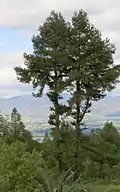 |  | P. leiophylla | Chihuahua pine | Mexico along the Sierra Madre Occidental and Sierra Madre del Sur from Chihuahua to Oaxaca, with a small extension into the United States in southeast Arizona and southwest New Mexico. |
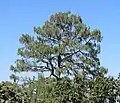 |  | P. lumholtzii | Lumholtz's pine | northwestern Mexico( states of Chihuahua, Durango, Zacatecas, Nayarit, Jalisco, Aguascalientes ). |
 |  | P. muricata | bishop pine | California, including several offshore Channel Islands, and a few locations in Baja California, Mexico. |
 | P. occidentalis | Hispaniolan pine | Dominican Republic and Haiti | |
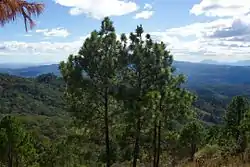 | 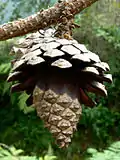 | P. oocarpa | egg-cone pine | Mexico and Central America. |
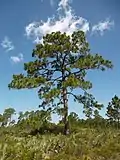 |  | P. palustris | longleaf pine | from East Texas to southern Maryland, extending into northern and central Florida |
 |  | P. patula | patula pine | Mexico (State of Veracruz on the Sierra Madre Oriental ) |
| P. praetermissa | McVaugh's pine | western Mexico. | ||
| P. pringlei | Pringle's pine | Mexico. | ||
 |  | P. pungens | Table Mountain pine | Appalachian Mountains in the United States. |
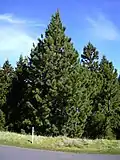 |  | P. radiata | Monterey pine | California and Mexico (Guadalupe Island and Cedros island) |
_just_north_of_U.S._Route_322_(Black_Horse_Pike)_in_Folsom%252C_Atlantic_County%252C_New_Jersey.jpg.webp) |  | P. rigida | pitch pine | eastern North America, from central Maine south to Georgia and as far west as Kentucky, and in two pockets along the St. Lawrence River in southern Quebec and Ontario |
 |  | P. serotina | pond pine | United States, from southern New Jersey south to Florida and west to southern Alabama. |
.jpg.webp) |  | P. taeda | loblolly pine | Southeastern United States, from East Texas to Florida, and north to southern New Jersey. |
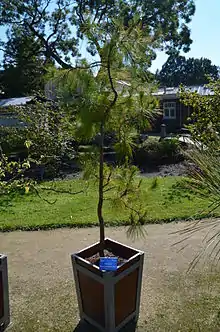 | P. tecunumanii | Tecun Uman pine | Mexico (Chiapas and Oaxaca) through Guatemala, Belize, El Salvador, Honduras to Nicaragua | |
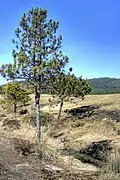 | P. teocote | Teocote pine | Mexico. | |
Fossils
- †P. foisyi - extinct
- †P. matthewsii – Pliocene, Yukon Territory, Canada[10]
Subsection Contortae
Subsection Contortae is native to North America and Mexico.[4]
| Image | Leaves & Cone | Scientific name | Common Name | Distribution |
|---|---|---|---|---|
.jpg.webp) | %252C_Acadia_NP%252C_Maine_1.jpg.webp) | P. banksiana | jack pine | Canada is east of the Rocky Mountains from the Mackenzie River in the Northwest Territories to Cape Breton Island in Nova Scotia, and the north-central and northeast of the United States from Minnesota to Maine, with the southernmost part of the range just into northwest Indiana and northwest Pennsylvania. |
 | _(6160285157).jpg.webp) | P. clausa | sand pine | Southeastern United States. |
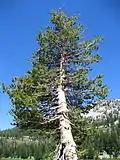 |  | P. contorta | lodgepole pine | western North America |
 |  | P. virginiana | Virginia pine | Long Island in southern New York south through the Appalachian Mountains to western Tennessee and Alabama. |
Subsection Ponderosae
Subsection Ponderosae is native to Central America, Mexico, the western United States, and southwestern Canada.[4][11]
| Image | Leaves & Cone | Scientific name | Common Name | Distribution |
|---|---|---|---|---|
 | _(32110379571).jpg.webp) | P. arizonica | Arizona pine | northern Mexico, southeast Arizona, southwest New Mexico, and western Texas in the United States. |
 | P. cooperi | Cooper's pine | Mexico. | |
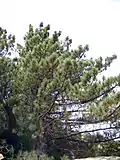 | .JPG.webp) | P. coulteri | Coulter pine | Southern California and northern Baja California (Mexico). |
 |  | P. devoniana | Michoacan pine | Mexico - from S. Sinaloa to Chiapas - and Guatemala |
 |  | P. douglasiana | Mexico | |
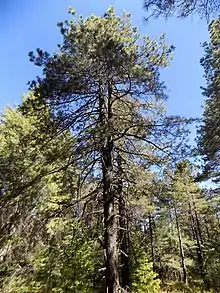 |  | P. durangensis | Durango pine | Sierra Madre Occidental mountain range of north-western Mexico. |
 |  | P. engelmannii | Apache pine | Northern Mexico, in the Sierra Madre Occidental with its range extending a short distance into the United States in southwestern New Mexico and southeastern Arizona. |
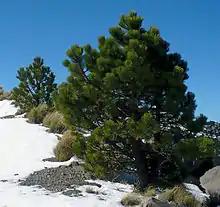 | P. hartwegii | Hartweg's pine | Mexico and Central America east to Honduras. | |
 |  | P. jeffreyi | Jeffrey pine | California, but also in the westernmost part of Nevada, southwestern Oregon, and northern Baja California. |
 |  | P. maximinoi | thinleaf pine | El Salvador, Guatemala, Honduras, and Mexico |
 | .jpg.webp) | P. montezumae | Montezuma pine | Mexico and Central America |
 |  | P. ponderosa | ponderosa pine | western North America. |
 |  | P. pseudostrobus | smooth-bark Mexican pine | Sinaloa, Mexico to El Salvador and Honduras. |
 |  | P. sabiniana | gray pine | California in the United States. |
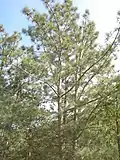 | 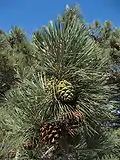 | P. torreyana | Torrey pine | northern San Diego county, and on Santa Rosa Island. |
Fossils
- †P. johndayensis – Oligocene
Subgenus Strobus
Subgenus Strobus includes the white and soft pines. Pines in this subgenus have one to five needles per fascicle and one fibrovascular bundle per needle, and the fascicle sheaths are deciduous, except in P. nelsonii, where they are persistent. Cone scales are thinner and more flexible than those of subgenus Pinus, except in some species like P. maximartinezii, and cones usually open soon after they mature.[5]
Section Parrya
Section Parrya has one to five needles per fascicle. The seeds either have articulate (jointed) wings or no wings at all. In all species except for P. nelsonii, the fascicle sheaths curl back to form a rosette before falling away. The cones have thick scales and release the seeds at maturity. This section is native to the southwestern United States and Mexico.[5]
Subsection Balfourianae
Subsection Balfourianae (bristlecone pines) is native to southwest United States.
| Image | Leaves & Cone | Scientific name | Common Name | Distribution |
|---|---|---|---|---|
 |  | P. aristata | Rocky Mountains bristlecone pine | Rocky Mountains in Colorado and northern New Mexico, with isolated populations in the San Francisco Peaks in Arizona and the Kaibab National Forest north of the Grand Canyon. |
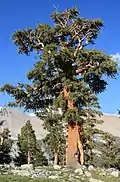 | .jpg.webp) | P. balfouriana | foxtail pine | California, United States. |
 | 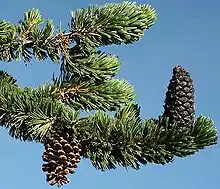 | P. longaeva | Great Basin bristlecone pine | California, Nevada, and Utah |
Subsection Cembroides
Subsection Cembroides (pinyons or piñons) is native to Mexico and the southwestern United States.
| Image | Leaves & Cone | Scientific name | Common Name | Distribution |
|---|---|---|---|---|
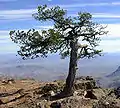 |  | P. cembroides | Mexican pinyon | Arizona, Texas and New Mexico in the United States into Mexico. |
 | _-_Flickr_-_S._Rae.jpg.webp) | P. culminicola | Potosi pinyon | Mexico, northern Sierra Madre Oriental in Coahuila and Nuevo León |
 | 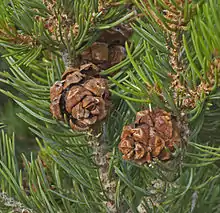 | P. edulis | Colorado pinyon | Colorado, southern Wyoming, eastern and central Utah, northern Arizona, New Mexico, western Oklahoma, southeastern California, and the Guadalupe Mountains in far western Texas |
 | 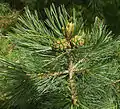 | P. johannis | Johann's pinyon | southeast Arizona and southwest New Mexico, United States, south in Mexico along the Sierra Madre Occidental and the Sierra Madre Oriental to southern Zacatecas and San Luis Potosí. |
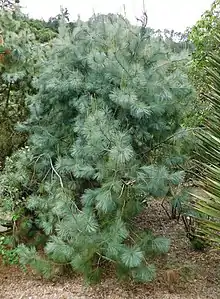 |  | P. maximartinezii | big-cone pinyon | Mexico, southern Sierra Madre Occidental in southern Zacatecas. |
 |  | P. monophylla | single-leaf pinyon | southernmost Idaho, western Utah, Arizona, southwest New Mexico, Nevada, eastern and southern California and northern Baja California. |
| P. orizabensis | Orizaba pinyon | central Mexico. | ||
 |  | P. pinceana | weeping pinyon | Mexico, in the states of: Durango; northern Coahuila, Nuevo León, and Zacatecas; central San Luis Potosí; and southern Querétaro and Hidalgo. |
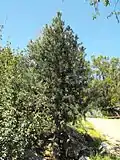 |  | P. quadrifolia | Parry pinyon | southernmost California in the United States and northern Baja California in Mexico |
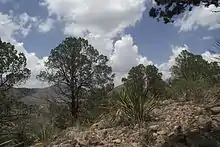 | P. remota | Texas pinyon or papershell pinyon | southwestern Texas and northeastern Mexico. | |
| P. rzedowskii | Rzedowski's pinyon | western Michoacan state, in southwestern Mexico. | ||
Subsection Nelsonianae
Subsection Nelsonianae is native to northeastern Mexico. It consists of the single species with persistent fascicle sheaths.
| Image | Leaves & Cone | Scientific name | Common Name | Distribution |
|---|---|---|---|---|
_(31179779021).jpg.webp) | _-_cone_-_Flickr_-_S._Rae.jpg.webp) | P. nelsonii | Nelson's pinyon | northeastern Mexico, in Nuevo León, San Luis Potosí and Tamaulipas |
Section Quinquefoliae
Section Quinquefoliae (white pines), as its name (which means "five-leaved") suggests, has five needles per fascicle except for P. krempfii, which has two, and P. gerardiana and P. bungeana, which have three. All species have cones with thin or thick scales that open at maturity or do not open at all; none are serotinous. Species in this section are found in Eurasia and North America, and one species, P. chiapensis reaches Guatemala.[12][13]
Subsection Gerardianae
Subsection Gerardianae is native to East Asia. It has three or five needles per fascicle.
| Image | Leaves & Cone | Scientific name | Common Name | Distribution |
|---|---|---|---|---|
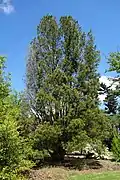 | _(30926705790).jpg.webp) | P. bungeana | lacebark pine | northeastern and central China |
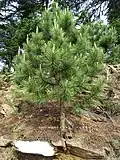 |  | P. gerardiana | chilgoza pine | northwestern Himalayas in northern Pakistan, and northwest India |
| P. squamata | Qiaojia pine | Qiaojia County, northeast Yunnan, China | ||
Subsection Krempfianae
Subsection Krempfianae is native to Vietnam. It has two needles per fascicle, and they are atypically flattened. The cone scales are thick and have no prickles.
| Image | Leaves & Cone | Scientific name | Common Name | Distribution |
|---|---|---|---|---|
| P. krempfii | Krempf's Pine | Vietnam in the Da Lat–Nha Trang area | ||
Subsection Strobus
Subsection Strobus has five needles per fascicle and thin cone scales with no prickles. Needles tend to be flexible and soft with slightly lighter side underneath.[14] It is native to North and Central America, Europe, and Asia.[4]
| Image | Leaves & Cone | Scientific name | Common Name | Distribution |
|---|---|---|---|---|
 |  | P. albicaulis | whitebark pine | Sierra Nevada, Cascade Range, Pacific Coast Ranges, and Rocky Mountains from Wyoming northwards. |
| P. amamiana | Yakushima white pine | Japan ( Yakushima and Tanegashima south of Kyūshū) | ||
 |  | P. armandii | Chinese white pine | China(southern Shanxi west to southern Gansu and south to Yunnan, with outlying populations in Anhui.)Taiwan, and northern Burma. |
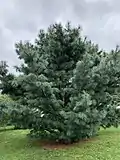 |  | P. ayacahuite | Mexican white pine | southern Mexico and western Central America |
 | P. bhutanica | Bhutan white pine | Bhutan and adjacent parts of northeast India (Arunachal Pradesh) and southwest China (Yunnan and Tibet). | |
 |  | P. cembra | Swiss pine | the Alps and Carpathian Mountains of central Europe, in Poland (Tatra Mountains), Switzerland, France, Italy, Austria, Germany, Slovenia, Slovakia (Tatra Mountains), Ukraine and Romania. |
%252C_San_Juan_Lachao%252C_Oaxaca%252C_Mexico_1.jpg.webp) | P. chiapensis | Chiapas pine | southern Mexico and Guatemala | |
| P. dabeshanensis | Dabieshan pine | Dabie Mountains in Anhui and Hubei provinces | ||
| P. dalatensis | Vietnamese white pine | Indochina, Vietnam, Laos | ||
| P. fenzeliana | Hainan white pine | Hainan | ||
 | .jpg.webp) | P. flexilis | limber pine | Western United States, Mexico, and Canada. |
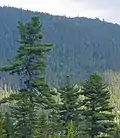 |  | P. koraiensis | Korean pine | eastern Asia: Korea, northeastern China, Mongolia, the temperate rainforests of the Russian Far East, and central Japan. |
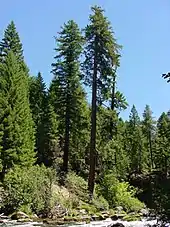 | 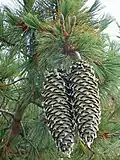 | P. lambertiana | sugar pine | the Pacific coast of North America, from Oregon through California to Baja California. |
 |  | P. monticola | western white pine | western United States and Canada |
.jpg.webp) |  | P. morrisonicola | Taiwan white pine | Taiwan |
.jpg.webp) | _-_Flickr_-_S._Rae_(2).jpg.webp) | P. parviflora | Japanese white pine | Korea and Japan. |
| P. hakkodensis ( P. pumila × P. parviflora) | Hakkoda pine | Japan. | ||
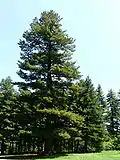 |  | P. peuce | Macedonian pine | Macedonia, Bulgaria, Albania, Montenegro, Kosovo, southwest of Serbia, and the extreme north of Greece |
 | _01.jpg.webp) | P. pumila | Siberian dwarf pine | Far East, Eastern Siberia, north-east of Mongolia, north-east of China, northern Japan and Korea |
 |  | P. sibirica | Siberian pine | Siberia and Mongolia |
 |  | P. strobus | eastern white pine | Newfoundland, Canada west through the Great Lakes region to southeastern Manitoba and Minnesota, United States, and south along the Appalachian Mountains and upper Piedmont to northernmost Georgia |
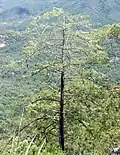 |  | P. strobiformis | Southwestern white pine (also Chihuahuan) | southwestern United States and Mexico. |
.jpg.webp) | _at_Bhandakthathaatch_(8000_ft)_I_IMG_7363.jpg.webp) | P. wallichiana | blue pine | eastern Afghanistan east across northern Pakistan and north west India to Yunnan in southwest China. |
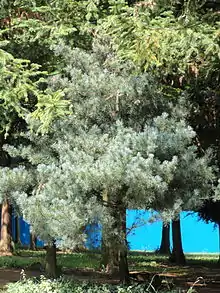 |  | P. wangii | Guangdong white pine | Yunnan Province of southern China |
Incertae sedis
Species which are not placed in a subgenus at this time.
- †P. peregrinus – Pinus peregrinus – Middle Eocene, Golden Valley Formation, North Dakota, USA
References
- Gernandt et al. 2005.
- Zeb et al. 2019.
- Frankis, Michael (2002). "Classification of the genus Pinus". The Lovett Pinetum Charitable Foundation.
- Gernandt et al. 2005, p. 35.
- Gernandt et al. 2005, p. 38.
- Stockey 1983.
- "Pinus cubensis". Germplasm Resources Information Network (GRIN). Agricultural Research Service (ARS), United States Department of Agriculture (USDA).
- "Pinus occidentalis". Germplasm Resources Information Network (GRIN). Agricultural Research Service (ARS), United States Department of Agriculture (USDA).
- Earle, Christopher J., ed. (2018). "Pinus". The Gymnosperm Database.
- McKown, Stockey & Schweger 2002.
- "Pinus hartwegii". Germplasm Resources Information Network (GRIN). Agricultural Research Service (ARS), United States Department of Agriculture (USDA).
- Gernandt et al. 2005, pp. 38–39.
- "Pinus chiapensis". Germplasm Resources Information Network (GRIN). Agricultural Research Service (ARS), United States Department of Agriculture (USDA).
- "Eastern white pine (Pinus strobus)". Minnesota Department of Natural Resources. St. Paul, Minnesota.
Bibliography
- Gernandt, D. S.; López, G. G.; García, S. O.; Liston, A. (2005). "Phylogeny and classification of Pinus". Taxon. 54 (1): 29–42. doi:10.2307/25065300. JSTOR 25065300.
- McKown, A.D.; Stockey, R.A.; Schweger, C.E. (2002). "A New Species of Pinus Subgenus Pinus Subsection Contortae From Pliocene Sediments of Ch'Ijee's Bluff, Yukon Territory, Canada" (PDF). International Journal of Plant Sciences. 163 (4): 687–697. doi:10.1086/340425. Archived from the original (PDF) on 2008-02-21. Retrieved 2011-05-16.
- Stockey, R.S. (1983). "Pinus driftwoodensis sp.n. from the early Tertiary of British Columbia". Botanical Gazette. 144 (1): 148–156. doi:10.1086/337355. JSTOR 2474678.
- Zeb, Umar; Dong, Wan-Lin; Zhang, Ting-Ting; Wang, Ruo-Nan; Shahzad, Khurram; Ma, Xiong-Feng; Li, Zhong-Hu (25 March 2019). "Comparative plastid genomics of Pinus species: Insights into sequence variations and phylogenetic relationships". Journal of Systematics and Evolution (published March 2020). 58 (2): 118–132. doi:10.1111/jse.12492. ISSN 1759-6831.
External links
- Tree of Life Web favors classification of Ducampopinus species in Strobus.
- NCBI Taxonomy server files Ducampopinus species above as Strobus.
| Wikimedia Commons has media related to Pinus. |